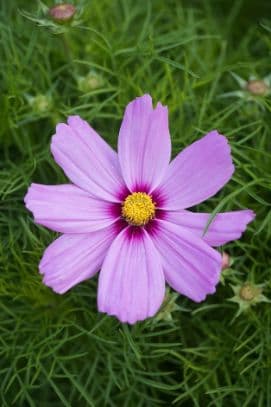Cosmea 'Casanova Pink' Cosmos bipinnatus 'Casanova Pink' (Casanova Series)

ABOUT
'Casanova Pink' is a compact annual to 40cm, with bright green, finely-divided, feathery foliage on branching, upright stems. Pink, saucer-shaped flowers 8cm across, with a dark pink mark at the base of the petals and a yellow button centre, are produced throughout the summer
About this plant
 Names
NamesFamily
Asteraceae.
Synonyms
Mexican Aster, Garden Cosmos, Cosmos.
Common names
Cosmos bipinnatus 'Casanova Pink'.
 Characteristics
CharacteristicsLife cycle
Annuals
Foliage type
Deciduous
Color of leaves
Green
Flower color
Pink
Height
2-3 feet (60-90 cm)
Spread
1-2 feet (30-60 cm)
Plant type
Herb
Hardiness zones
2-11
Native area
Mexico
Benefits
 General Benefits
General Benefits- Attracts Pollinators: Cosmos flowers are known to attract bees and butterflies which are beneficial for pollination.
- Low Maintenance: Cosmos bipinnatus 'Casanova Pink' requires minimal care, making it suitable for gardeners of all skill levels.
- Drought Tolerant: Once established, these plants are quite tolerant of drought, reducing the need for frequent watering.
- Long Blooming Period: They have a lengthy flowering season, providing color in the garden from early summer to fall.
- Easy to Grow: These plants are not demanding and can thrive in a variety of soil types, even if they are not rich or fertile.
- Enhances Garden Aesthetics: With its vibrant pink flowers, it adds an element of beauty and charm to any garden or landscape.
- Great for Cut Flowers: The long stems and attractive blooms make excellent cut flowers for arrangements and bouquets.
- Self-Seeding: They often reseed themselves, which can provide new plants for the following year without additional planting.
- Fast Growing: Cosmos plants grow relatively fast, allowing for quick establishment and enjoyment of the blooms.
- Beneficial for Wildlife: Provides a food source for wildlife, as the seeds that follow the flowers can feed birds.
 Medical Properties
Medical PropertiesThis plant is not used for medical purposes.
 Air-purifying Qualities
Air-purifying QualitiesThis plant is not specifically known for air purifying qualities.
 Other Uses
Other Uses- The dried petals of Cosmos can be used to create natural confetti for weddings or celebrations, providing an eco-friendly alternative to plastic confetti.
- Cosmos can be incorporated into educational gardens or school projects to teach students about plant life cycles, pollination, and the importance of biodiversity.
- With its vibrant pink blooms, Cosmos can be used in artistic floral photography, providing a beautiful subject or backdrop that adds color and interest.
- The sturdy stems of Cosmos make them suitable for use in lightweight plant structures, such as decorative garden trellises or teepees when intertwined with other plants.
- Used in textile dyeing, the flowers of Cosmos can provide natural dyes that impart a range of pink hues to fabrics, a practice known as botanical dyeing.
- Cosmos petals can be incorporated into handmade papers, giving texture and decorative elements to stationery and other paper crafts.
- As a part of sensory gardens, Cosmos' soft petals and distinctive floral scent can provide a tactile and olfactory experience, particularly for visually impaired visitors.
- In culinary presentations, fresh Cosmos petals can be used as a delicate garnish for desserts and salads, though they should not be consumed in significant quantities.
- Cosmos can be included in potpourri blends, contributing color, shape, and a mild natural fragrance to the mixture.
- The plant can be used as a natural colorant in crafting eco-friendly candles, where the pink petals can impart soft hues to the wax.
Interesting Facts
 Feng Shui
Feng ShuiThe Cosmos flower is not used in Feng Shui practice.
 Zodiac Sign Compitability
Zodiac Sign CompitabilityThe Cosmos flower is not used in astrology practice.
 Plant Symbolism
Plant Symbolism- Love and Devotion: The Cosmos bipinnatus, commonly known as the Cosmos, often embodies love and devotion with its dainty and vibrant flowers.
- Beauty and Harmony: Cosmos are seen as symbols of beauty and harmony, representing the balanced order of the universe reflected in their symmetrical petals.
- Peace and Tranquility: The gentle sway of Cosmos in the breeze is reminiscent of a peaceful state, making them symbols of tranquility.
- Innocence: The delicate nature of Cosmos flowers is frequently associated with the purity and innocence found in their simple yet elegant appearance.
- Wholeness: The Greek origin of the name 'Cosmos' means 'order' or 'world,' symbolizing the sense of wholeness and inclusion in the grand scheme of things.
 Water
WaterCosmos, commonly known as Garden Cosmos, should be watered regularly but allows the soil to dry out between watering sessions to prevent root rot. It's ideal to water them once a week with about one to two gallons, depending on the weather conditions; hot, dry climates may require more frequent watering. A deep watering is preferable to encourage deeper root growth. During the growing season, increase the frequency to ensure consistent soil moisture, but always check that the top inch of soil is dry before watering again.
 Light
LightGarden Cosmos thrives in full sunlight and should be placed in a spot where it can receive at least 6 to 8 hours of direct sunlight daily. They can tolerate partial shade, but too much shade may lead to leggy plants and reduced flowering. Ensure the Cosmos receives ample morning sun, which is less intense than the afternoon sun, to promote healthy growth and abundant blooms.
 Temperature
TemperatureGarden Cosmos prefer a moderate temperature range and can tolerate temperatures as low as 25°F before being at risk of frost damage. They thrive in temperatures between 60°F and 90°F, which is the ideal range for optimal growth and flowering. However, they can survive in higher temperatures if provided with sufficient water to prevent wilting.
 Pruning
PruningPruning Garden Cosmos is important for maintaining their shape and encouraging continuous blooming. Pinch off the tips of young plants to encourage branching, and deadhead spent flowers regularly to promote new blooms. Pruning should be done throughout the blooming season, which is typically from midsummer until the first frost. The best time to prune is in the morning when the plant is well-hydrated.
 Cleaning
CleaningAs needed
 Soil
SoilGarden Cosmos, commonly known as Cosmos, thrives in well-draining soil with a neutral to slightly acidic pH between 6.0 and 7.0. A best soil mix for Cosmos would contain equal parts of garden soil, peat or compost, and perlite or sand to ensure proper drainage and aeration. Fertility should be moderate as high fertility can lead to excessive foliage at the expense of bloom.
 Repotting
RepottingCosmos are typically grown as annuals and therefore do not require repotting as they are generally sown directly into the garden or container where they will bloom for a single season. In the case of growing perennials or saving plants, repotting can be done in early spring before the new growth starts.
 Humidity & Misting
Humidity & MistingCosmos are not particularly humidity-sensitive and can thrive in a range of humidity levels found in typical outdoor environments. They do not require high humidity environments and can perform well with the ambient humidity levels generally encountered in temperate climates.
 Suitable locations
Suitable locationsIndoor
Place in bright, indirect light and keep soil moderately moist.
Outdoor
Plant in full sun, well-drained soil, and water moderately.
Hardiness zone
2-11 USDA
 Life cycle
Life cycleCosmos 'Casanova Pink' begins its life when a seed germinates in soil after the last frost date, provided it's in a location with ample sunlight and well-drained soil. Emerging seedlings develop true leaves and transition to the vegetative growth stage, focusing energy on developing a strong stem and leaf structure. As it matures, the plant enters the flowering stage, where it produces its characteristic pink, daisy-like flowers, attracting pollinators to help with the reproduction process. Following pollination, the flowers develop into seed heads containing seeds that can be dispersed by wind or animal movement. If conditions allow, these seeds can drop to the soil to self-sow, lying dormant until the next season. Alternatively, the plant can be propagated intentionally by collecting and sowing seeds or by dividing established plants.
 Propogation
PropogationPropogation time
Spring-early summer
Propogation: Cosmos bipinnatus 'Casanova Pink', commonly known as Cosmos, is most commonly propagated through seeds. The ideal time to sow Cosmos seeds is in early spring, after the last frost when soil temperatures reach approximately 60 degrees Fahrenheit (15.6 degrees Celsius). To propagate, simply scatter the seeds directly onto a well-drained soil surface and lightly cover them with a thin layer of soil. Water the area gently until the seeds germinate, which typically occurs within 7 to 10 days. Thinning the seedlings to around 12 to 18 inches (30 to 46 centimeters) apart ensures that each plant has enough space to grow. This method is favored for its simplicity and effectiveness in producing a garden filled with these beautiful pink blooms.









